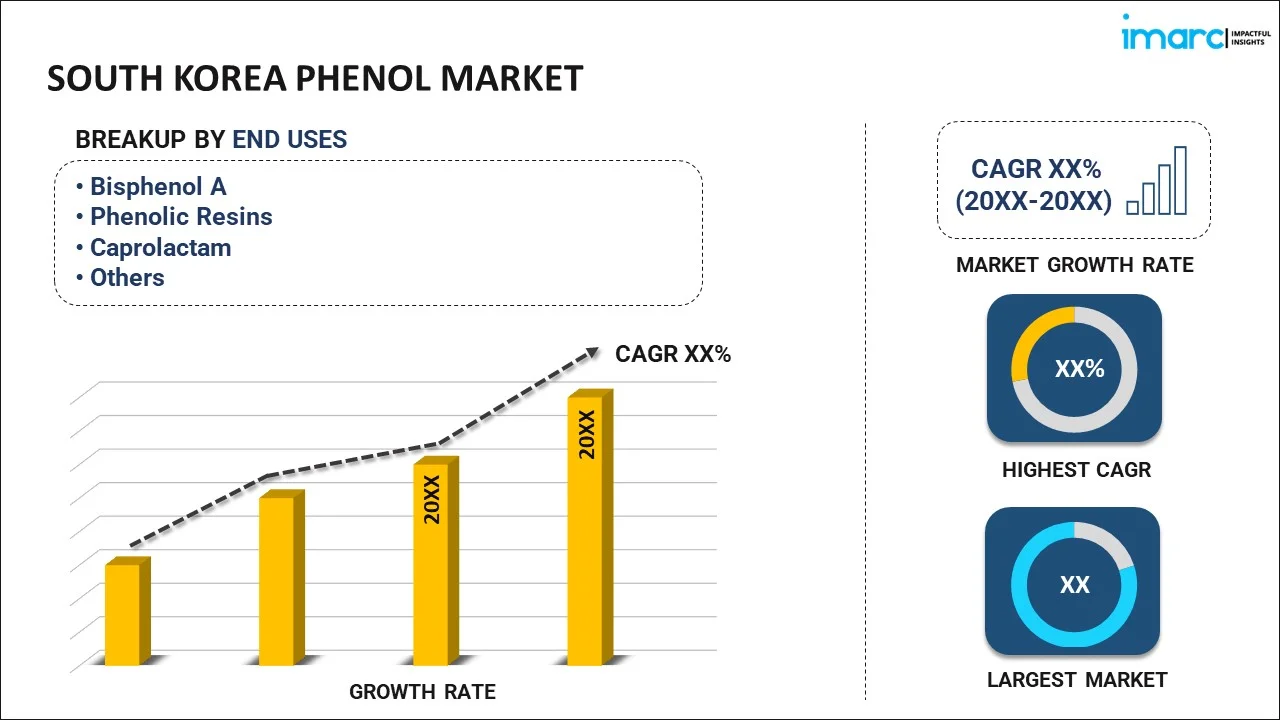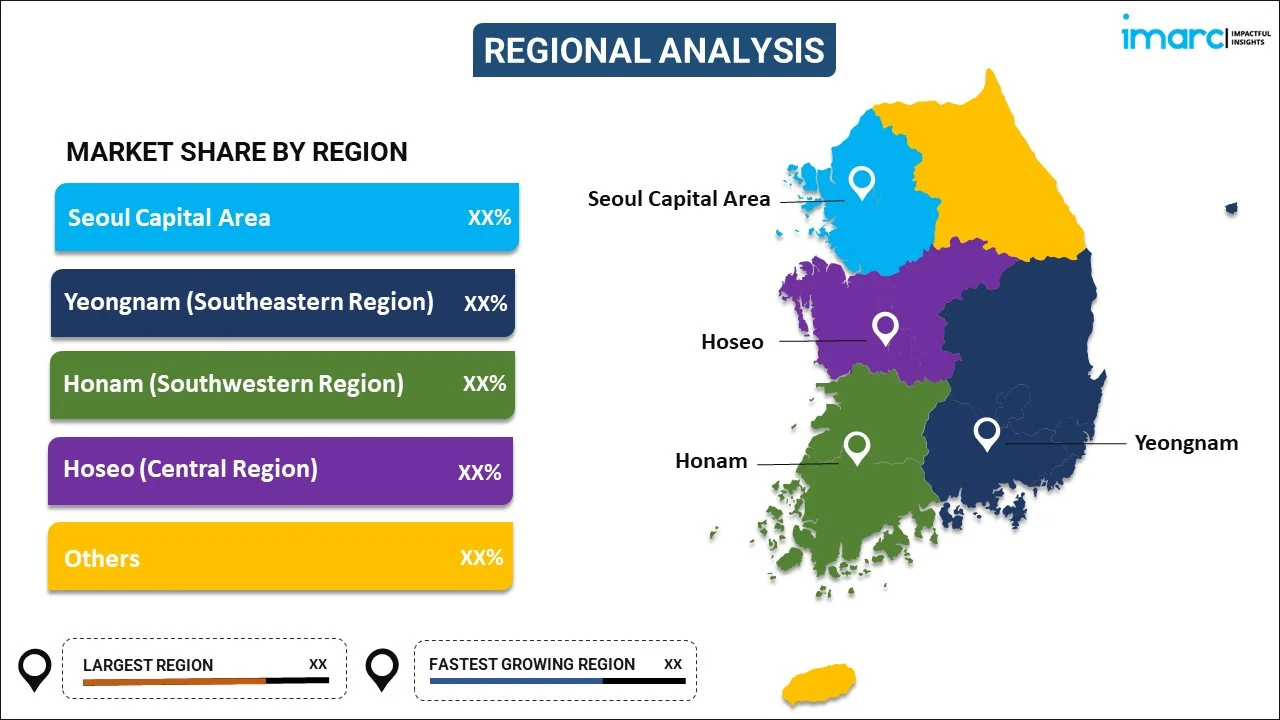
South Korea Phenol Market Report by End Use (Bisphenol A, Phenolic Resins, Caprolactam, Alkyl Phenyls, and Others), and Region 2025-2033
Market Overview:
South Korea phenol market size reached USD 465.6 Million in 2024. Looking forward, IMARC Group expects the market to reach USD 675.7 Million by 2033, exhibiting a growth rate (CAGR) of 4.2% during 2025-2033. The growing demand for this liquid, as it aids in providing essential materials for sectors, such as pharmaceuticals, agrochemicals, and various specialty chemicals and supporting the nation's economic growth, is primarily driving the market growth.
|
Report Attribute
|
Key Statistics
|
|---|---|
|
Base Year
|
2024 |
|
Forecast Years
|
2025-2033 |
|
Historical Years
|
2019-2024
|
| Market Size in 2024 | USD 465.6 Million |
| Market Forecast in 2033 | USD 675.7 Million |
| Market Growth Rate (2025-2033) | 4.2% |
Phenol exists in a crystalline state at room temperature, appearing as a white substance. It forms robust hydrogen bonds, enhancing its solubility in water compared to alcohol, and exhibits higher boiling points in comparison to hydrocarbons of similar molecular weight. With mild acidity and caustic properties, phenol exists as either a colorless liquid or a white solid, gradually darkening when exposed to light and emitting a distinctively sweet odor. Historically, phenol was produced synthetically through the sulfonation and chlorination of benzene. However, contemporary manufacturing processes involve the conversion of benzene and propylene into cumene, subsequent oxidation into cumene hydroperoxide, and hydrolysis leading to the formation of phenol. This modern method provides a more efficient means of obtaining phenol from precursor chemicals.
South Korea Phenol Market Trends:
The South Korea phenol market stands as a vital component within the country's chemical industry, reflecting its role in various manufacturing processes and applications. Moreover, it is integral to the production of a wide range of chemical products, contributing significantly to the nation's industrial landscape. Besides this, phenol, with its mildly acidic and caustic nature, is employed as a key raw material in the synthesis of plastics, resins, and other chemicals essential for diverse industries, thereby positively influencing the regional market. Moreover, the manufacturing of phenol in South Korea has evolved over time, shifting from historical synthetic processes involving benzene sulfonation and chlorination to more contemporary methods. Presently, this product is typically produced by converting benzene and propylene into cumene, followed by oxidation into cumene hydroperoxide, and finally, hydrolysis to yield phenol. The modern production approach not only ensures efficiency but also aligns with contemporary environmental and sustainability considerations. Apart from this, its presence as a versatile and foundational chemical underscore its significance in the synthesis of numerous products, that will position the South Korea phenol market as a key player in the country's chemical and industrial sectors in the coming years.
South Korea Phenol Market Segmentation:
IMARC Group provides an analysis of the key trends in each segment of the market, along with forecasts at the country level for 2025-2033. Our report has categorized the market based on end use.
End Use Insights:

- Bisphenol A
- Phenolic Resins
- Caprolactam
- Alkyl Phenyls
- Others
The report has provided a detailed breakup and analysis of the market based on the end use. This includes bisphenol A, phenolic resins, caprolactam, alkyl phenyls, and others.
Regional Insights:

- Seoul Capital Area
- Yeongnam (Southeastern Region)
- Honam (Southwestern Region)
- Hoseo (Central Region)
- Others
The report has also provided a comprehensive analysis of all the major regional markets, which include Seoul Capital Area, Yeongnam (Southeastern Region), Honam (Southwestern Region), Hoseo (Central Region), and Others.
Competitive Landscape:
The market research report has also provided a comprehensive analysis of the competitive landscape. Competitive analysis such as market structure, key player positioning, top winning strategies, competitive dashboard, and company evaluation quadrant has been covered in the report. Also, detailed profiles of all major companies have been provided.
South Korea Phenol Market Report Coverage:
| Report Features | Details |
|---|---|
| Base Year of the Analysis | 2024 |
| Historical Period | 2019-2024 |
| Forecast Period | 2025-2033 |
| Units | Million USD |
| Scope of the Report | Exploration of Historical Trends and Market Outlook, Industry Catalysts and Challenges, Segment-Wise Historical and Future Market Assessment:
|
| End Uses Covered | Bisphenol A, Phenolic Resins, Caprolactam, Alkyl Phenyls, Others |
| Regions Covered | Seoul Capital Area, Yeongnam (Southeastern Region), Honam (Southwestern Region), Hoseo (Central Region), Others |
| Customization Scope | 10% Free Customization |
| Post-Sale Analyst Support | 10-12 Weeks |
| Delivery Format | PDF and Excel through Email (We can also provide the editable version of the report in PPT/Word format on special request) |
Key Questions Answered in This Report:
- How has the South Korea phenol market performed so far and how will it perform in the coming years?
- What has been the impact of COVID-19 on the South Korea phenol market?
- What is the breakup of the South Korea phenol market on the basis of end use?
- What are the various stages in the value chain of the South Korea phenol market?
- What are the key driving factors and challenges in the South Korea phenol?
- What is the structure of the South Korea phenol market and who are the key players?
- What is the degree of competition in the South Korea phenol market?
Key Benefits for Stakeholders:
- IMARC’s industry report offers a comprehensive quantitative analysis of various market segments, historical and current market trends, market forecasts, and dynamics of the South Korea phenol market from 2019-2033.
- The research report provides the latest information on the market drivers, challenges, and opportunities in the South Korea phenol market.
- Porter's five forces analysis assist stakeholders in assessing the impact of new entrants, competitive rivalry, supplier power, buyer power, and the threat of substitution. It helps stakeholders to analyze the level of competition within the South Korea phenol industry and its attractiveness.
- Competitive landscape allows stakeholders to understand their competitive environment and provides an insight into the current positions of key players in the market.
Need more help?
- Speak to our experienced analysts for insights on the current market scenarios.
- Include additional segments and countries to customize the report as per your requirement.
- Gain an unparalleled competitive advantage in your domain by understanding how to utilize the report and positively impacting your operations and revenue.
- For further assistance, please connect with our analysts.
 Inquire Before Buying
Inquire Before Buying
 Speak to an Analyst
Speak to an Analyst
 Request Brochure
Request Brochure
 Request Customization
Request Customization




.webp)




.webp)












